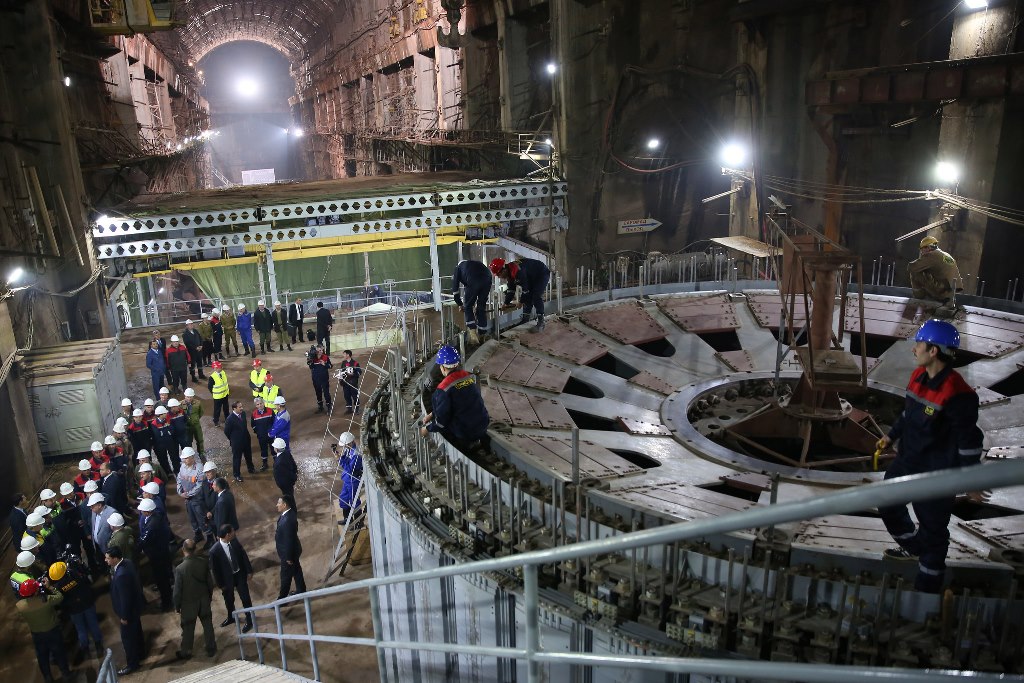The Majlisi Namoyandagon (Tajikistan’s lower chamber of parliament) today enhanced amendments proposed by the government to the country’s law on privatization of state-owned properties.
The amendments, in particular, provides for attracting investments for completion of construction of the Roghun hydroelectric power plant (HPP) and development of the Tajik Aluminum Company (TALCO).
Meanwhile, when journalists asked the deputy head of the State Committee on Investment and State-owned Property Management (GosKomInvest), Orzu Ahmadzoda, who participated in the Majlisi Namoyandagon sitting, to comment on the amendments, he refrained to clarify essence of the adopted amendments.
By the RT Law “Privatization of State-owned Properties”, which was adopted in in February 2009, the Nurek and Roghun HPPs and TALCO are not subject to privatization. They are recognized as facilities of national and strategic importance.
Roghun HPP
This year, Tajikistan plans to spend 2.1 billion somoni (equivalent to some 220 million U.S. dollars) for completion of construction of the Roghun HPP. Provision of this amount has been made in the national budget for 2020.
The Ministry of Finance is carrying out work on attracting preferential loans from international financial institutions for construction of the Roghun HPP.
According to official data, 28 billion somoni have been provided from all sources of financing since the beginning of construction of the Roghun hydropower plant.
Tajikistan stemmed the flow of the Vakhsh River for construction of the Roghun hydroelectric power plant (HPP) mega-dam in late October last year. Explosions were used on October 29 to block the main riverbed of the Vakhsh River, marking the first substantial step toward building the dam. The work on the Vakhsh River has not affected existing hydroelectric facilities downstream.
Roghun HPP is an embankment dam in the preliminary stages of construction on the Vakhsh River in southern Tajikistan. It is one of the planned hydroelectric power plants of Vakhsh Cascade.
The Roghun HPP was first proposed in 1959 and a technical scheme was developed by 1965. Construction began in 1976 but the project was frozen after the collapse of the Soviet Union.
An agreement on finishing the construction was signed between Tajikistan and Russia in 1994; however, as the agreement was not implemented, it was denounced by Tajikistan parliament.
In October 2004, Tajikistan signed an agreement with Russia's RusAl aluminum company, according to which RusAl agreed to complete the Roghun facility and rebuild the Tursunzoda aluminum smelter. In August 2007, Tajikistan formally revoked a contract with RusAl, accusing it of failing to fulfill the contract.
In April 2008, Tajikistan founded OJSC NBO Roghun with an authorized capital of 116 million somoni for completing the construction of the Roghun HPP. Current authorized capital of OJSC NBO Roghun reportedly amounts to more than 12 billion somoni.
To raise funds to complete construction of the Roghun HPP the government started to sell shares in Roghun to people on January 6, 2010. Tajikistan has reportedly issued 6 billion somoni worth of Roghun shares.
In response to the request of the bordering countries and especially Uzbekistan, the World Bank has financed the Techno-Economic Assessment Study (TEAS) conducted by consortium of Coyne et Bellier, Electroconsult and IPA Energy + Water Economics, and Environmental and Social Impact Assessment (ESIA) conducted by Poyry. The ESIA was published on June 16, 2014 and the TEAS in July 2014. Overall, the ESIA stated that “Most impacts are rather small and easily mitigated, if mitigation is required at all.” and that “There is no impact of the category “strong negative, mitigation not possible,” which would have to be considered as a no-go for the project.”
In 2016, construction duties on Roghun were assigned to Italian company Salini Impregilo. It is estimated that the project will cost $3.9 billion to complete.
The project is broken down into four components, with the most expensive one involving the building of a 335-meter-high rockfill dam — the tallest in the world — which will entail costs of around $1.95 billion. Construction of the Roghun hydropower plant is expected to be completed in 2033.
Two of the six turbines have already started producing energy for sale to raise funding to complete it. The first turbine went into service in November last year and the second one was introduced into operation in September this year.
If built as planned, the dam will be the tallest in the world at 335 meters and have a capacity of 3600 MW.
TALCO
The Tajik Aluminum Company is fully state-controlled enterprise. Radio Liberty’s Tajik Service reported on December 4 that Tajikistan is on the cusp of selling a stake in TALCO to a Chinese company. RFE/RL cited China’s former ambassador to Tajikistan, Yue Bin, as saying that the acquisition would be executed in return for the Chinese company investing $545 million into the TALCO aluminum producer. Yue offered no details about the size of any stakes to be sold
TALCO has not commented publicly on the prospect of it being part-privatized. However, the conditions for sale have been created. By government’s decree TALCO was converted from a state unitary enterprise into an open joint-stock company on November 1, 2019. Although the shares all now belong to the government, a portion may in time be traded to private investors.






